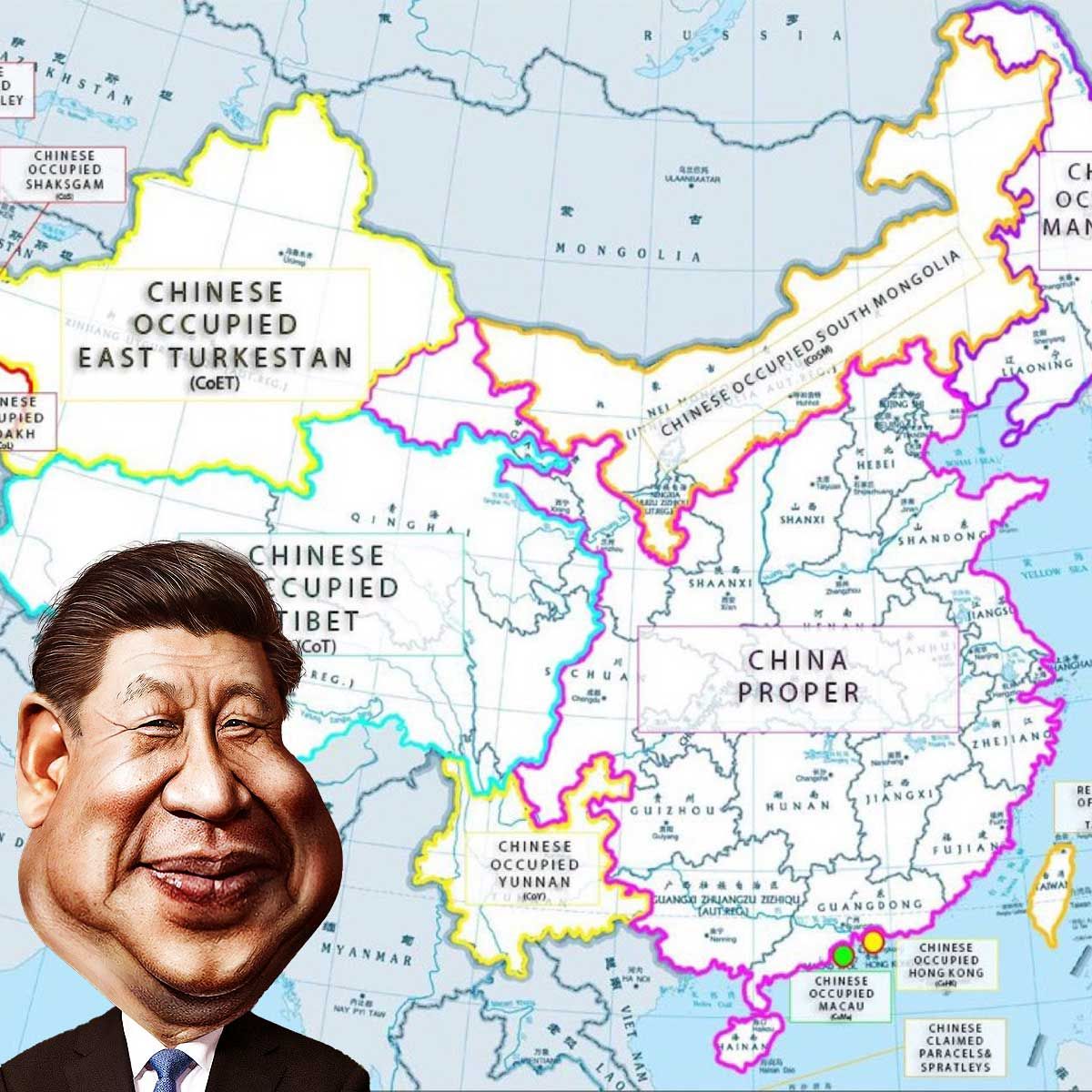More Coverage
Twitter Coverage
Satyaagrah
Written on
Satyaagrah
Written on
Satyaagrah
Written on
Satyaagrah
Written on
Satyaagrah
Written on
JOIN SATYAAGRAH SOCIAL MEDIA
"Greed's frontier: The harsh truth of expansionism": Amid the furore over China releasing a new map, Ex-Chief of Army Staff General Manoj Naravane shared a map of China and took a dig saying "finally someone has got the map of China as it really is"

In the midst of an evolving geopolitical landscape, the age-old contention surrounding China's territorial claims resurfaces, igniting sparks of debate and discussions on sovereignty and integrity. A recent development has seen China releasing a contentious land-border map, which challenges India's territorial sovereignty by marking Indian regions of Ladakh and Arunachal Pradesh as its own. This narrative, however, contains a significant amount of exaggeration and misinformation that demands a closer scrutiny.
|
First and foremost, it must be noted that technically, there exists no direct land border between India and China. In reality, Tibet and East Turkestan serve as buffer regions separating the two nations, delineated by the majestic ranges of Karakoram and the Himalayas. Unfortunately, these buffer states have witnessed aggressive occupation by China in the past century, thereby altering the dynamics of the region.
Historically, Tibet and East Turkestan have always maintained their independent identities. While the province of Gilgit-Baltistan, a part of Jammu & Kashmir currently under Pakistani control, lies to the north of Kashmir Valley, the adjacent region to its east is widely recognized as East Turkestan, although referred to as 'Xinjiang' by China. This region was forcibly occupied by the Red Chinese army around 1949.
Furthermore, the historical trajectory of Tibet is marked by periods of independence and moments of being a vassal to other empires. In the 7th century CE, Tibet established itself as a dominant force, often overlooked by the Chinese Tang Dynasty. The Tibetan forces, recognizing their advantageous position in the high-altitude plateau, expanded their territories into Chinese lands in the west and north. The formidable geography of Tibet, with an average elevation of 16,000 feet, prompted the Chinese to resort to diplomacy, resulting in a peace treaty that involved paying vassalage and arranging royal marriages with Tibetan Kings.
|
Moreover, Tibet has a deep-rooted spiritual connection with the Mongols, having served as their spiritual capital for centuries. Unfortunately, this rich heritage faced a grim period when China occupied Tibet around 1951, culminating in the tragic loss of thousands of Buddhist monks. The Dalai Lama, the spiritual and temporal leader of Tibet, found refuge in India in March 1959, establishing a Tibetan Government in exile, thereby continuing the legacy and the struggle for a free Tibet.
This recent move by China not only ignites fresh tensions but also brings to light the historic battles and alliances that shaped this region. The false claims in China's new map, thus, stand challenged by the resilient histories of Tibet and East Turkestan, nations that once flourished with remarkable independence and vibrant cultural legacies.
In the tangle of borders and geopolitical interests, the region of Ladakh, nestled between the states of Tibet and East Turkestan, has become a focal point of contention, largely because of its strategic position and abundant natural resources. The simmering separatist movements in Tibet and East Turkestan have fueled China's relentless pursuits in Ladakh, partly driven by its intent to secure invaluable water resources and untapped reserves of metals, oil, and gas. Tibet, famously termed as the "third Pole" owing to its glaciers, is a source of monumental rivers like Indus and Brahmaputra, which not only serve as lifelines but are potential tools for geopolitical dominance.
|
The unabating assertiveness of China in this region has manifested through various strategies aimed at incremental occupation, notably the tactic known as "salami-slicing." A glaring instance of this strategy was the unauthorized construction of the G-219 highway in the Aksai-Chin portion of Ladakh around 1953, forging a link between the restless regions of Tibet and East Turkestan. This encroachment escalated over the years, peaking with the occupation of additional Ladakhi territories in 1962 and culminating in the controversial agreement with Pakistan in 1963, which saw China gaining control over the strategically significant Shaksgam Valley in Gilgit.
Tibet, comprising a staggering one-eighth of China's total landmass, witnessed a similar fate. Its abundant natural resources, particularly water resources capable of satisfying a significant fraction of China's needs, made it a prime target for occupation. This acquisition further allows China to wield control over several lower-riparian states, thus consolidating its position of power in the region.
|
Delving into the historical tapestry of East Turkestan reveals the deep roots of the Uyghur community, known for their Turkish lineage and Central Asian origins. The establishment of Islam in this region can be traced back to the 8th century CE, with the arrival of the Abbassid army dispatched by the Caliph of Baghdad. Despite the Qing Emperor's capture of East Turkestan in the 18th century, the region enjoyed periods of autonomy, functioning as an independent state in the early 20th century. However, the tides changed drastically when the Communist party ascended to power in China in 1949, heralding an era of aggressive integration of peripheral lands like East Turkestan, which witnessed a forceful assimilation and subsequent resistance against Chinese rule, especially after its renaming to Sinkiang around 1955.
As we thread these narratives together, it becomes increasingly evident that the region is embroiled in a complex web of historical claims, contested borders, and resource-driven ambitions. The recent aggressions, including the May 2020 attacks at various strategic points in Ladakh, signify a continuation of this aggressive strategy, heralding uneasy times in this geopolitically significant region. It behooves the global community to remain vigilant and foster dialogues that uphold the principles of sovereignty and territorial integrity.
Therefore, in the accompanying map, all these areas have been shown as independent states under Chinese occupation has been spotlighted. The extent of China's border disputes spans not only land but also maritime boundaries, encompassing several nations. Its territorial claims sometimes seem to defy historical and geographical logic, an instance being the claim over the entire expanse of Siberia, despite Russia being a close ally.
Another contentious point is the maritime boundary disputes China entertains with its neighboring countries. The ambitious claim over Indonesia’s Natuna Sea, located a staggering 1500 nautical miles from the nearest Chinese shoreline, mirrors China’s intent to wield control over significant maritime trade routes. The South China Sea, a term coined by the Portuguese in the 16th century, has become a nucleus of dispute, with China asserting dominance through militarization and infrastructure development, rejecting international arbitration efforts such as the 2016 UNCLOS award.
|
In stark contrast, India's historical influence over the region paints a picture of a civilization extending its reach not through conquest, but through the dissemination of its rich cultural, philosophical, and religious tapestry. Its impact, spanning over two millennia, can be traced back to flourishing empires like Funan, Champa, Sri Wijaya, and Majapahit, that were deeply rooted in Indian philosophy, religion, and science. These empires, regarded as custodians of sea trade and culture, operated under principles derived from Hindu and Buddhist doctrines, showcasing the profundity of Indian influence in the region.
These ancient maritime empires, thriving between the 1st and 16th centuries CE, were characterized by the pervasive use of Sanskrit as a common language, rulership principles based on the 'Chakravartin' concept, and architectures heavily influenced by Indian styles. Their legacies, echoing the resonance of Indian thought and diplomacy, serve as testaments to a period of cultural symbiosis and flourishing trade, underscored by a shared philosophical outlook and cultural exchanges.
As we navigate the intricate labyrinth of historical claims and contemporary disputes, it becomes imperative to foster dialogue that acknowledges the rich tapestry of influences that have shaped the region. Amidst the escalating tensions, the need for diplomacy that upholds the sanctity of historical connections and encourages peaceful coexistence becomes more prominent than ever. The unfolding narrative beckons a nuanced approach that respects the interwoven histories and promotes harmonious relations amidst the nations embroiled in these disputes.
In the complex panorama of Asian geopolitics, the history of maritime trade and cultural exchanges provides a profound narrative that extends beyond the boundaries drawn on modern maps. For centuries, the Indian subcontinent has been a significant hub for trade and cultural dissemination, its influence stretching far across the seas up to regions such as Papua-New Guinea in the Pacific Ocean. The ancient ports along the Indian coastline facilitated seamless interaction between the east and the west, fostering a trade network that was prolific and robust.
|
Navigating the monsoon winds with expertise, Indian sailors set sail on dhows, establishing vibrant trade routes between the Chinese seas and prominent Indian provinces, including Bengal, Orissa, Tamilnadu, Kerala, Maharashtra, and Gujarat. The maritime trade flourished as these Indian sailors mastered the art of harnessing the seasonal winds, fostering prosperous commercial exchanges.
In stark contrast, China's maritime ventures were characterized by periods of stagnation and intermittent expansion. Although the Song Empire ushered in a period of open sea trade in the 10th century, this momentum was lost with the fall of the empire in the early 12th century. Subsequent attempts by the Ming Empire to revitalize maritime trade in the 15th century proved to be short-lived.
Acknowledging the significant and broad-ranging influence of Indian culture and commerce in the region, French archaeologists coined the term 'Indo-Chine', a testimony to the deep-rooted Indian legacy in these areas. The nomenclature captures the essence of a time when the boundaries between India and China were porous, defined not by territorial claims but by the rich exchange of ideas, goods, and philosophies.
Today, the aggressive territorial claims by China threaten to overwrite this rich tapestry of shared history and culture. The waters, historically known as the 'Champa Sea' and the 'West Philippines Sea', bear witness to a time when the region was a melting pot of influences, where India and China contributed equally to the flourishing civilizations.
It is perhaps a timely juncture to revisit this history, to rename the remaining seas as the 'Indo-China Sea', thereby recognizing the joint legacy and contributions of both these ancient civilizations. This gesture, far from being symbolic, should serve as a reminder to China about the spirit of collaboration and shared heritage that once defined the region, a stark contrast to their current cartographic aggressions.
As we stand on the cusp of a new era, the accompanying map, with revised nomenclatures, is not just a geographical representation, but a call to embrace the intertwined histories and shared legacies. It serves as a stern lesson against territorial aggression and an invitation to revisit the rich collaborative past, fostering a future built on mutual respect and understanding. It urges us to look beyond territorial claims and to celebrate the deep-rooted connections that have historically united the region, steering towards a path of peace and cooperative growth.
 Support Us
Support Us
Satyagraha was born from the heart of our land, with an undying aim to unveil the true essence of Bharat. It seeks to illuminate the hidden tales of our valiant freedom fighters and the rich chronicles that haven't yet sung their complete melody in the mainstream.
While platforms like NDTV and 'The Wire' effortlessly garner funds under the banner of safeguarding democracy, we at Satyagraha walk a different path. Our strength and resonance come from you. In this journey to weave a stronger Bharat, every little contribution amplifies our voice. Let's come together, contribute as you can, and champion the true spirit of our nation.
 |  |  |
| ICICI Bank of Satyaagrah | Razorpay Bank of Satyaagrah | PayPal Bank of Satyaagrah - For International Payments |
If all above doesn't work, then try the LINK below:
Please share the article on other platforms
DISCLAIMER: The author is solely responsible for the views expressed in this article. The author carries the responsibility for citing and/or licensing of images utilized within the text. The website also frequently uses non-commercial images for representational purposes only in line with the article. We are not responsible for the authenticity of such images. If some images have a copyright issue, we request the person/entity to contact us at satyaagrahindia@gmail.com and we will take the necessary actions to resolve the issue.
Related Articles
- "Unity in strategy, strength in partnership": Amid China's rising influence in the Indo-Pacific, Germany strengthens military relations with 'reliable' India, eyeing secure trade routes and strategic collaborations while stepping up military ties
- "There is no path to peace. Peace is the path": NSA Ajit Doval's arrival in Jeddah represents India's commitment to dialogue and diplomacy, his belief - a peaceful resolution to the Ukraine conflict - remains India's utmost priority and greatest desire
- Bangladesh and India put the final nail in the coffin of China’s ‘String of Pearls’ with access to Chittagong port as it was offered by PM Sheikh Hasina for use by India for trade and uninterrupted commerce
- Explained: China’s Village Construction In Bhutan’s Territory And What It Wants To Achieve With This Creeping Invasion
- “It’s not the destination, it's the journey”: India becomes 2nd-largest country with the biggest road network after beating China with total road network of 63.32 lakh km comprising all categories - national & state highways and urban & rural roads
- Western sanctions on Russia, with 19,535 measures imposed since 2022, aimed to cripple its economy but instead drove alliances with China, India, Iran, and North Korea, boosting trade, diversifying its economy, and weakening Western dominance
- "Connectivity is power; India realizes it first": India takes the lead in the Himalayan railway race, outpacing China in connecting with Nepal, amid geopolitical intricacies, as the tracks extends, Nepal emerges as a crucial nexus in this Asian power play
- Washington Post quietly edits 2020 report that had branded Covid-19 origin from a Wuhan lab as ‘debunked conspiracy theory’
- Chinese authorities tortured and arrested Tibet Monks for ‘leaking info’ after forcing them to watch the demolition of 99 foot tall Buddha in Draggo county, Kham, Tibet
- Terrorism, Pakistan, COVID, Afghanistan and more: Here’s all that PM Modi and US VP Kamala Harris discussed in the bilateral meet
- "Good news comes in large packages": 2023 #HenleyPassportIndex Passport Index is out for the year, leapfrogging seven spots to 80th place, Indian passport holders now enjoy visa-free entry to 57 countries, a significant step up in global mobility
- Modi govt invites applications from non-Muslim refugees from Afghanistan, Pakistan, Bangladesh to grant Indian citizenship
- Viral video: Mayhem at UK stadium for vaccination, thousands gather only to be denied vaccine after waiting for hours
- Rahul Gandhi schooled by Externals Affair Minister Dr. S Jaishankar of history lessons and is condemned by Law Minister Kiren Rijiju for his remarks on the judiciary and Election Commission
- Hold your breath as in the pageant held in Israel Harnaaz Sandhu of India crowned Miss Universe 2021




























